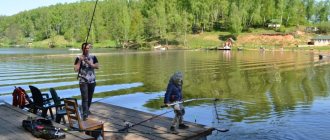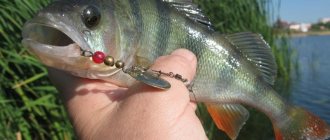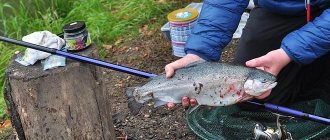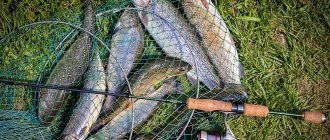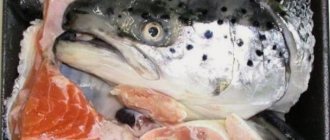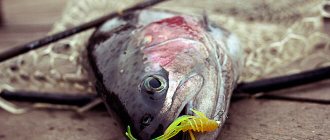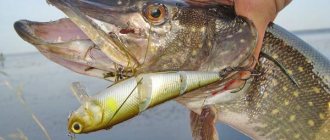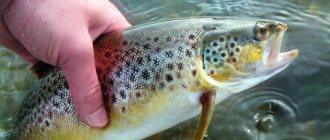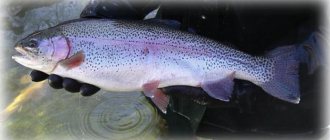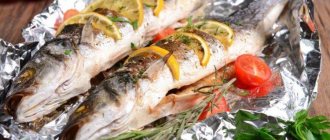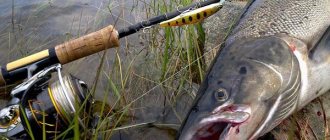Trout is the common name for species of salmon fish. It has great commercial value; many fishermen are fond of fishing it. It is considered a noble fish and is valued in cooking. Its meat contains vitamins and microelements. It is fried, smoked, salted, and taken raw.
Trout is divided into many subspecies and forms. Depending on living conditions, time and place of reproduction, and feeding period, the appearance of these fish changes, acquiring the features of one or another subspecies or form. The phenotype (appearance) of salmon fish is variable.
There is no consensus among ichthyologists about whether any form belongs to a specific species or even genus. The exception is species that have long lived in the same rivers or lakes. Recently, due to the introduction, relocation and acclimatization of new species, changes in habitual living conditions, many new forms and variants have formed among well-established species.
Three species are of greatest interest to amateur fishermen: lake trout, brook trout, and a newcomer from distant America—rainbow trout.
All species have a similar body shape. Slightly stretched, compressed from the sides. Males are small in size and have more teeth. Trout have small, dense scales. Two dorsal fins - main and adipose. The color depends on its location. When the day is light, the fish is silvery with black spots. On a dark bottom it is darker. Brook trout is brown in color and its head may be black. Black and red spots are randomly located throughout the body. She is called the pestrushka.
The color of the fish changes during the mating season. The body is dark, covered with orange stripes with bright spots. The pelvic fins turn orange.
Trout is a predatory fish and its diet consists of small fish, insects, and mollusks living near the surface of the water. Feeding occurs throughout the year, even during the spawning period.
Where and when do you catch trout using lures?
Possessing high gastronomic qualities, trout attracts the attention of many anglers. She does not like temperatures above 20 degrees. Found in cool rivers and ponds. Early spring is considered a good time for fishing. This predator is very careful; spinning fishing with spinners gives greater effect.
Spinner is an artificial bait that comes in many varieties. You can throw it anywhere. For example, where it is impossible to deliver live bait.
It is used when fishing for predatory fish. Pike, perch, pike perch, asp, trout - this is not a complete list of underwater inhabitants that fall for this bait.
You can fish for trout all year round. This fish loves cool and clean water. On a hot day, it goes into the depths, and with sunset it comes back to the surface. Therefore, it is better to catch it in the evening and all night.
In spring, this species is caught in the late afternoon, and in autumn it bites all day long. It is especially active during the flight of the mayfly. This is the end of May and the beginning of June.
Habitats: mountain rivers and large lakes. The fish is very shy; complete silence is needed for successful fishing. When going fishing, wear camouflage clothing to be invisible against the background of nature. Trout are positioned against the current, in fast water. Approach the fish site carefully, otherwise the school will move to another place.
In winter, trout bite on different spoons, it all depends on the reservoir. Winter spinners with golden and copper colors are more suitable.
Seasonal features of choosing trout spinners
Trout are very careful. This circumstance makes fishing exciting. An interesting tackle for trout is spinning. It is important to choose the best lure to catch these fish. Classification of spinners is very difficult. They are divided into winter and summer, perch and pike. There is a big difference between winter and summer ones: summer ones move horizontally in the water, and winter ones move vertically.
Summer types of spinners:
Oscillating (oscillators) - a curved metal plate in the shape of a fish. On one side it is attached to the fishing line through a ring, and on the other it is equipped with a tee. Moving in the water, it makes rhythmic oscillatory movements, which attracts fish.
- Rotating spoons (spinners) are complex and thin structures. A petal plate and special beads are placed on a wire rod. A tee is attached to the end of the rod. By stretching such gear in the water, the angler creates vibrations and noise, which also attracts fish.
- Acoustic spinners, when retrieved, produce sounds that are audible to fish. To do this, ordinary metal balls are built into it. Winter types of spinners:
- Diving ones look like small fish on metal plates. Weights are soldered onto them to imitate the movement of a fish. Such spoons are used when fishing from ice.
- Horizontally submersible - metal spoons with a fishing line attached in the middle. When thrown into the water they move in a circle.
Fishing with horizontal spoons is learned in advance. A good effect is achieved when catching burbot, which grabs the prey across. In this case, a horizontal spoon guarantees a hook.
Winter
Trout are caught using spoons when the ice becomes strong and you can go out on it without fear. The fish is constantly moving around the pond, so it’s impossible to sit in one place. If there is no bite for 10-15 minutes, then move to another place. Greater activity is observed at sunrise; during the day the bite weakens.
There are paid reservoirs filled with fish. No one returns without a catch, but there is no excitement, like on a natural body of water.
The fish are biting on different lures. The most catchy ones for trout fishing in winter:
- Daiwa Silver Creek;
- Smith Pure;
- Rublex Celta turbo;
- Lukris Pulpos Luky;
- Mepps Black Fury.
For winter trout fishing from ice, you must remain quiet, do not scare them away, and do not knock on the ice. Start drilling holes from the shore to the center of the lake. Having found a difference in depth, stop and start flashing.
If the place is unfamiliar, then, if possible, ask local fishermen about the reservoir. Take a simple fishing rod for trolling. To prevent the fish from pulling all the gear into the hole, tie a light strip with a diameter larger than the hole perpendicular to the whip.
The jig is suitable for any color and shape, but the hook must be sharp. The technique of the game involves falling and raising the jig with stops. When there is a bite, the wiring should be energetic, and when the bite is rare, it should be slow.
Spring
Trout lives where there are no other fish. Therefore, when planning to catch it, tune in only to this type of fish.
For fishing, a rigid spinning rod up to 3.5 meters long is used. The reel is taken with high speed, line with a diameter of 0.25-0.30 millimeters. It is better to use a thinner line, this will make it easier to guide the bait, which is important for trout.
There are two methods of guiding trout spoons - with a descent in a circle and with a release downstream, in a straight line.
The first method is used when fishing is done from the shore or a coastal ledge. Throwing the tackle upstream and allowing the bait to sink to the bottom, the tackle is raised. Under the force of the current, the bait moves in a wide arc, moving from the bottom to the surface.
In a situation where it is necessary for it to sink to the bottom when approaching the shore, the fishing line is pulled up immediately after touching the water or a few seconds earlier. By changing the speed of the retrieve, the fishing depth also changes. This method is very good for checking large boulders located in the riverbed, or slopes and edges placed in front of the angler of pools and holes.
In the second case, using the force of the current, the bait is thrown forward along the riverbed for some distance, and then, reeling in a fishing line, the bait is pulled against the current. By turning the rod, the bait is delivered to where the fish may be.
By increasing the speed of the spinner, it is lifted to the upper layers of the water, and by decreasing it, it is lowered to the bottom. The best way to catch trout is with bait that is found in this reservoir. This could be caddisfly or other insect larvae, which can be easily collected in the river or on the shore.
Autumn
Autumn is different from other trout fishing seasons. Cool nights begin, the fish become aggressive, fattening up before winter. At this moment, large specimens may be caught.
Daytime is good for fishing. Trout can be found near riffles with stones, in holes. You won’t find it in a shallow place anymore.
The choice of gear when fishing determines its success. For float fishing, choose a longer rod; for shy fish, long casts are made.
The most catchy lures for trout in the fall are “spinners.” They are cheap and effective. Size is not important; even a small bait can be taken by a large specimen.
Suitable colors are silver and purple. Red and yellow baits confuse the fish, reminding them of fallen leaves. “Spreaders” are also successful when fishing for trout.
In autumn, this fish no longer stands at the surface of the water. Therefore, the selected baits must be deep-sea.
Micro-switches for trout
Today, micro-oscillators are very specific and at the same time universal baits. Those who know how to fish successfully use them. Moreover, they catch not only trout, for which these baits were originally intended, but also predators more familiar to us: perch, chub, asp...
We asked one of the leading spinning players in Russia, our regular author Andrey Pitertsov, to answer some questions about micro-oscillators.
RnR:
What do you mean by micro-oscillator?
A.P.:
Micro-spinning spoons are usually understood as spinners weighing a maximum of 5-6 g, but in fact it turns out that when we take spinners weighing 2-3-4 g with us and go to a mountain river or reservoir without a current (trout fishing ), most likely the situation will be such that we will need baits with a large weight (6–7, sometimes even 8 g), so by micro-oscillators I propose to mean baits weighing mainly up to 5–6 g, but sometimes it is possible to use 7 –8‑gram models.
RnR:
Does it make sense to fish with micro-oscillators in still water?
A.P.:
Yes, that makes sense. For example, trout fishing in paid ponds has recently become very popular in central Russia. Actually, microoscillators were developed for these purposes.
Now I would like to consider various options for the behavior of trout on the platform.
Paid ponds vary in size. These can be small rectangular ponds only a hundred meters long, and in some cases small reservoirs a kilometer or more long.
Let's consider the option when the released trout actively moves around the water area in search of food. In this case, we will need long-range spoons, since the fish can manifest themselves in completely different places. It will not be difficult for active fish to chase a fast-moving bait. Therefore, it is long-range spoons that will help us reach the fish and get under its nose.
If the water is cloudy, then it is better not to waste time with the size of the bait. Trout will notice a larger bait earlier and from a greater distance. The optimal spinners for these conditions are Smith Heaven 5g, Coatac 8g, Forest MIU 5g and Forest MIU 8g.
If the water is clear, the situation changes dramatically. In this case, we need to be careful when choosing the size of the vibrator. Let's just say that there is a certain line in the size of spinners, crossing which you can lose up to half of the bites. The optimal spinners, in my opinion, for clear water and active fish are around 3 g, but in some cases you can lower the bar to 1.5 g. Among them are: Smith Pure 3.5 g, Forest Crystal 3 g, Smith P. Area 2.4 g, Smith Pure 2 g, Forest MIU 1.5 g.
Now let's look at fishing for passive trout. Passive trout move little and, as a rule, practically do not show their presence with splashes. Again, consider both cases with water transparency.
In muddy water, paradoxically, even for passive fish, spinners of quite impressive sizes, but not heavy ones, still work. In this case, range is no longer paramount. The optimal spinners here are Coatac 5 g, Daiwa SONO S 7 g, Forest MIU 5 g. If you need to fish the bait at a depth of about 1.5 m, then we use 4–5 gram spinners, but if there is a need to penetrate depths of about 3 m, then As a rule, you can’t do without 7-gram baits.
The best wiring is uniform on average, or better at a slow pace. Sometimes you can diversify it with stops. In some periods, trout react positively to stopping the spoon.
The next and most difficult situation is passive fish and clear water. Time after time, micro-oscillators measuring up to 2.5 cm and weighing up to 1.5 g show themselves to be the best in such conditions. The best here are Coatac 0.8 g, Smith P. Area 1.4 g, Forest M2 0.8 g, Forest Marvel 0.6 g.
The best retrieve is slow and steady, on the verge of spinner action. It is better to change the wiring horizon not by the speed of rotation of the reel handle, but by “playing” with the diameter of the fishing line. That is, if we need to carry such a light vibrator at a depth of about 2 m, then we take the thinnest cord (according to the Japanese classification, about 0.4). When fishing at shallower depths, use a slightly thicker cord (about 0.6–0.7) or monofilament with a diameter of about 0.15 mm.
RnR:
Andrey, in what cases do you use micro-oscillators when fishing in fast currents?
A.P.:
This is exactly the case when I practically never fish with spoons lighter than 5 g. As a rule, in upstream or drifting currents it is more convenient to fish with a spinner or a wobbler. These two types of baits tend to “cling” to the current, and they can be retrieved more slowly. The spoon will be carried away faster by the current, and the trout will have much less time to detect and grab it. In addition, even if the trout comes out, it very often misses such a quickly carried bait, which, for example, in competition conditions is simply unacceptable.
However, in some cases I still use micro-oscillators for fishing on mountain rivers. Let's say there is a deep pit under the opposite bank. The mass of the bait in this case will be impressive - about 6-8 g. Such a bait will allow us to throw it under the opposite bank, especially if the river is wide enough (the above-mentioned spinner and wobbler simply may not reach there).
After casting, you should not immediately start reeling in the line. You need to deepen the bait into the pit and thereby try to lure the fish standing at the bottom. Other types of bait simply won’t allow us to do this.
But what about fast-sinking wobblers? Yes, in a number of cases their use in the described situation is justified, but only if the depth in the pit is no more than 3 m. If the pit is deeper, then the vibrator is unrivaled.
It is also beneficial to use oscillators at the deep junction of jets. Let's say a powerful stream passes under the shore where you are standing. And under the opposite bank there is calm. As a rule, trout stand at the border between the current and calm water. If the depth does not exceed one and a half meters, then it is most convenient to fish such places using heavy spinners and deep-sea wobblers. But if the current is very powerful or the depth is over 2–2.5 m, the best here will be compact spinners weighing 6–8 g. Here are some baits that are well suited for these places: Pontoon21 Sinuoso Spoon 7 g, Acme Kastmaster 7 g, Forest MIU 8 G.
RnR:
Which fishing line is best to use when fishing with micro-oscillators?
A.P.:
It all depends on the specific fishing conditions. If this is a mountain river and we are fishing by long casting with baits weighing 5–7 g, it is better to use 0.5–0.6 braid (according to the Japanese classification). The cords I use most often are YGK JigMan X4 and Pontoon21 Extreama.
The situation changes dramatically if we fish in still water. There are times when trout cruise along the shore and there is no need for long casting. Here it is most convenient to use monofilament with a diameter of 0.12–0.16 mm, depending on the conditions. Because of its softness, it dampens the jerks of strong fish over a short distance, preventing a large number of escapes.
But if the trout has moved away from the shore to a distance of 4050 m, then you simply cannot do without bait weighing 5–7 g and a thin cord. It will be very difficult to get there with a monofilament line.
RnR: Are there any special criteria when choosing a rod for fishing with micro-oscillators? A.P.: In principle, I don’t have any special requirements for fishing rods. These are the models that are comfortable to fish in specific conditions (test, length, etc.). As a rule, I prefer fast or extrafast tuning.
For long-distance fishing, the choice falls on rods between 7'3″ and 7'6″ feet. This, on the one hand, allows you to fish comfortably with light tackle, on the other hand, at least a little, but it adds to the casting range. For these purposes, I often use the following models. For current: Daiko Featherweight 7'3″ T 1.5–10.5 g, Graphiteleader Tiro 7'6″ 1–12 g, Pontoon21 Seven& Half 7'6″ 3.5–12.5 g. For standing fishing water (if long casting is not needed): Black Hole Hi‑Light 6'62" 2–7 g, Major Craft AIRock 7'0″ 0.5–5 g.
RnR:
What kind of wiring do you use when fishing with micro-oscillators in still water?
A.P.:
By simple experimentation, it turned out that trout respond best to a classic uniform retrieve or a uniform retrieve with stops. And, as a rule, the smaller the oscillator, the better it works with uniform wiring on the verge of failure, that is, at the slowest pace possible. Usually these are spinners weighing 1–2 g.
Variations are already possible in the wiring of heavier oscillators. For example, sometimes trout respond better to a pause in the retrieve. One nuance - the pause in the wiring should not be abrupt, that is, there is no need to instantly stop the rotation of the coil. We slow down a little and then stop. The number of revolutions between pauses is five to six.
RnR:
What kind of wiring do you use when fishing with micro-oscillators in the current?
A.P.:
There are many more variations on the theme... It all depends on the specific place. That is, if we take as an example the same pit under the opposite bank that we mentioned above, then we try to cast as close to the water’s edge as possible and let the spoon go deeper. Then we start retrieving in the “soft twitching” style, that is, gentle jerks with the rod while simultaneously reeling in the fishing line. After the bait has left the pit, as a rule, you can reel it out. Much depends on the direction of the current. If we cast perpendicularly or slightly downstream, then the retrieve itself is slower. If we are casting upstream, then the best retrieve here will be a fast one with pauses - 4-5 turns at a fast pace (the pace is chosen based on the speed of the current; the bait should be slightly ahead of the flow speed) - pause. If the depth at the fishing spot is about 2–3 m, then a pause of 1 second will be quite enough.
RnR:
Would you go to a mountain stream with only a set of microcola beams?
A.P.:
If I were a fan of fishing with micro-spinners, then maybe I would have gone. My opinion is that micro-spinners are bait for a specific place, and not throughout the river. Micro-oscillators, as mentioned above, work worse than spinners or wobblers when driven downstream. But in places where there is great depth, oscillators have no competition.
RnR:
Would you go to a paysite only with microcola beams?
A.P.:
Yes, why not. Micro spinners are one of the best baits for catching trout. In terms of catchability, only wobblers can compete with them.
It’s difficult for me to explain why, but it happens that trout respond better to wobblers, and sometimes to spoons. But still, trout is almost always caught using micro-oscillators. At the very least, I would definitely go to the paysite only with them.
RnR:
The age-old question: is it better to use a single or tee on micro-oscillators?
What do you think about this? A.P.:
A very interesting question, vigorously discussed among fans of ultralight and light fishing.
It seems to me that the single fishing rod itself holds the fish better, but on the other hand, the number of bites with it is somewhat lower. A single fishing rod is good when the fish attacks the bait from behind. This is what trout usually do on fishing grounds. On mountain rivers, wild trout attack baits, as a rule, from different sides, so it is more convenient to fish here with a tee. But the river is different. There are rivers with a lot of sharp stones, a large number of snags, an abundance of grass at the bottom, etc.
In this case, the angler is required to have more precise control over the spoon, otherwise a snag cannot be avoided. It makes sense to use a single player here. But here everything depends more on the fisherman himself.
RnR:
You only talked about trout fishing.
Is it really true that micro-oscillators don’t catch anyone in Russian conditions anymore? A.P.:
Of course, they catch you. Micro spinners are one of the most convenient baits for catching schooling perch, as well as chub and asp.
For example, when a school of perch is fattening, it is not so picky - it bites on almost everything. Something else is important. When the perch cauldron boils now on the right, now on the left, at different distances, then in this case the bait should have a greater “destructive force”. That is, with a 5–6 gram spoon on thin braid and a rod about 7’6″ long you can cast 50–60 meters. This is a huge area that no other bait can cover, except perhaps a light retractable leash. But a micro-oscillator allows you to fish the entire water column, adapting to the location of the perch.
As for asp and chub, a micro-spinner is generally one of the main baits. Previously, the same asp could be caught with a 21-gram castmaster, but now, under conditions of strong pressure, it is necessary to reduce the size and weight of baits.
I’ll give an example of fishing for asp and chub using micro-oscillators.
Let’s say that in front of us is a riffle with a depth of about 1.5–2 m, below the riffle there is a hole. In this case, it is most convenient, so as not to frighten the fish on the very rift, to anchor the boat about ten meters from the entrance to the hole. It is better to cast upstream or slightly at an angle. It is best to move the bait in a stepwise manner - 3-4 turns - pause for about 2 seconds. Bites occur not only during a pause, but also during reeling. On purely uniform wiring, bites happen an order of magnitude less.
RnR:
In what cases do you prefer micro-oscillators for these fish (perch, chub, asp)?
A.P.:
I’ll start with what micro-oscillators I use when fishing for perch. These can be heavy 7-8 grams, but also lighter ones - 3-4 grams. It all depends on the size of the perch and its mood.
If you catch asp and chub, then the spoon should be medium-sized. For example, with a 10-gram castmaster you can catch 5 fish in a morning, while with a 7-gram castmaster you can catch 7-8. Moreover, this does not mean that a larger bait will catch a larger fish.
At the moment the water bodies are under pressure, it seems to me that the size of the oscillators, 7–8 g, is borderline. When using larger baits, the number of bites will be noticeably less.
For asp and chub, the best ones are compact spoons weighing 6–7 g, which fly well. I usually use Acme Kastmaster 3.5 and 7 g, Pontoon21 Sinuoso Spoon 7 g, Forest MIU 8 g
When fishing for asp and chub, I usually use the same models as for trout, but sometimes a little longer - around 8 feet. This is at least a little, but it will add casting, which in some cases is very important.
What kind of spoons are used for trout fishing?
The choice of spinners depends on the fishing location:
- You can search for brook trout on a spinning rod throughout the year. Here the spoon must work steadily in the current.
- Lake or pond trout are caught using small baits. Here the fish have enough food; spinning fishing continues until the ice freezes completely.
Rotating spoons for trout:
- Mepps turntables - the petal works stably at slow retrieves. The Aglia series are popular.
- Wordens Rooster Tails. They have special plumage like a fly.
- Flash spinners from Blue Fox have a heavy core, which allows you to catch larger fish.
- The Myran Akka spinner is designed for currents and creates a lot of noise in the water.
Suitable spinners for trout:
- Daiwa Presso Rave spinner. Suitable for fishing in shallow water, weight up to 2.5 grams, has a low oscillation frequency.
- A series of PriSpoon spinners from Skagit Designs. Works in fast currents, loaded to the full depth.
- The Bassday Kangoku Raptor spinner has good long-casting characteristics and stable play.
- The Forest Miu Native spinner represents a classic lure for trout fishing. Very similar to a fry.
Criteria for choosing trout spoons
Anglers are often surprised that one spoon can bring a lot of bites in a lake, but in a river trout are no longer interested in anything. Why? It's all about the food supply of the fish. Let us note the following points:
1. The so-called brook trout is found in rivers. You can catch it all year round, but the activity of the fish will depend on the weather, as well as the fishing season. When choosing a spoon for brook trout, the choice should be made in favor of models that are stable in the current.
2. Pond or lake trout live in better or more comfortable conditions. In their natural environment, fish do not have problems with food. You can fish from spring to late autumn. When fishing in still water, miniature spoons are mainly used.
It is necessary to select a lure for trout fishing primarily based on the season of the year.
• In the spring it begins to actively feed, replenishing its strength after the winter cold. During this period, the fish are less cautious, thanks to which anglers manage to sneak as close as possible to the areas where trout feed. In spring, trout are caught using baits that emit fish or insects. The spinner is deployed at a depth of 1-2 meters.
• Starting from June, trout activity becomes even better; the predator begins to feed in all layers of water. Trout, starting from the first days of summer, occupies areas of the water area where it remains until the onset of autumn. In summer, the best bite will be in the early morning or close to dark. Wiring should begin immediately after the spoon is in the water. The bait is moved quickly so that the fish cannot see it.
IMPORTANT! The best bite is observed immediately after heavy rains, when the water becomes a little cloudy.
• Starting from mid-September, experienced spinning anglers switch to a targeted search for trophy trout. Note that in the fall the mating season begins for fish. It is distributed evenly throughout the reservoir. For fishing in the coastal zone, light spinners are used, and for long-distance casting, front-loaded spinners weighing up to 10 grams are used.
What criteria are used to select a lure for trout fishing?
Spoons for trout fishing are the main criterion for successful fishing. The choice of bait is also made according to the seasons:
- In spring, trout are less careful; they begin to feed after winter. The fisherman manages to get close to the fish. They are caught using baits similar to fry and insects. The wiring goes under the surface of the water;
- At the beginning of summer, trout feed a lot; they are found throughout the entire depth. A good time is early morning, the bait is cast quickly.
Spinner spoons of the “spinning” type work well in different waters and have excellent flight qualities.
When choosing them, pay attention to the following features:
- selection by size - fish weight 700 grams - bait length up to 5 cm, fish weight 1 kilogram - bait length up to 8 cm;
- The weight of the spoon depends on the speed of the current and the required casting distance.
In medium currents it is advisable to have a bait weighing up to 5 grams, and in still water you can use micro-oscillators;
- The color of the bait should be varied; red and pink shades are suitable for trout.
When choosing a spoon, consider the depth of the reservoir. In shallow water the bait should be light. Some anglers use a spinner with a thick core. This bait has a stable game.
Pay attention to the size of the reservoir; not every bait can be cast far.
The best lures for trout:
- Forest Miu Native 2.8;
- Daiwa Skinny Spoon 1,2;
- Williams Wabler W30;
- Mepps Black Fury No. 2;
- Daiwa Silver Creek Spinner R;
Where to start fishing at different times of the year
Fish activity depends on the season. Trout are considered cold-loving, so the peak bite occurs in the winter and spring months. Once on a pond in the spring, you need to choose active models of wobblers from your ammunition load. The color depends on the weather, water transparency and the mood of the fish. The administration of paid ponds tries to monitor the cleanliness of the reservoir, so in the cold season you can start with dark colors. However, the predator itself does not always favor natural colors. Having studied the set of wobblers for trout fishing by an experienced fisherman, you can understand that most of them are made in bright, provocative shades.
To learn more:
Rating of the best wobblers for pike
As the weather gets warmer, the fish become lethargic and don’t bite as often. In summer, the results show trout baits for twitching. The wiring is performed with noticeable pauses. Fish walking in the upper layers can be seen with the help of polarized glasses. This gives an advantage over other fishermen, especially if the spinner has an accurate cast.
In winter, the predator is caught from the ice using sinking baits, for example, rattlins. Color and size depend on the specific body of water, so don’t shy away from experimenting.
DIY trout spoon
The easiest way is to make a “oscillator”. Making the “rotator” is harder and more complex.
What materials to make it from?
The handle of a stainless spoon with drilled holes on both ends is a good spoon for catching any fish. For trout spoons you will have to think and work a little.
You will need:
- Sheet copper 1 mm thick.
- Metal scissors.
- Hammer.
- File and sandpaper.
Using metal scissors, we cut out a “vibration” shape from a sheet of copper, 35 mm long and 12 mm wide at the head. Weight about 2.2-2.5 g.
We take a hammer and with a few blows we make a spinner out of this blank, similar to a factory one. We punch or drill holes at the ends and clean them with sandpaper.
Now we check her game in a container of water. The frequency is measured by the bending angle of the entire spoon. We put a ring on one side and a hook on the other. You can tune this lure - attach several red threads to the hook, it will become more noticeable to the fish.
It is more difficult to make a spinner spoon for trout fishing with your own hands. You will need a tool and some skills to work with it. The fish should have no doubt that this is not a living fry.
To work you will need:
- Brass or copper petal.
- Beads of different colors.
- Polymer tubes.
- Clamps, threads.
- Steel wire with a diameter of at least 0.5 mm.
The cut petal is fixed on the axis with a clamp, beads and a polymer tube are put on the axis. The end of the wire rod is twisted into a ring to secure the hook. The rotation of the petal itself depends on the quality of the clamp. Make all the parts in advance from copper blanks - this will give the “pinwheel” a golden color.
